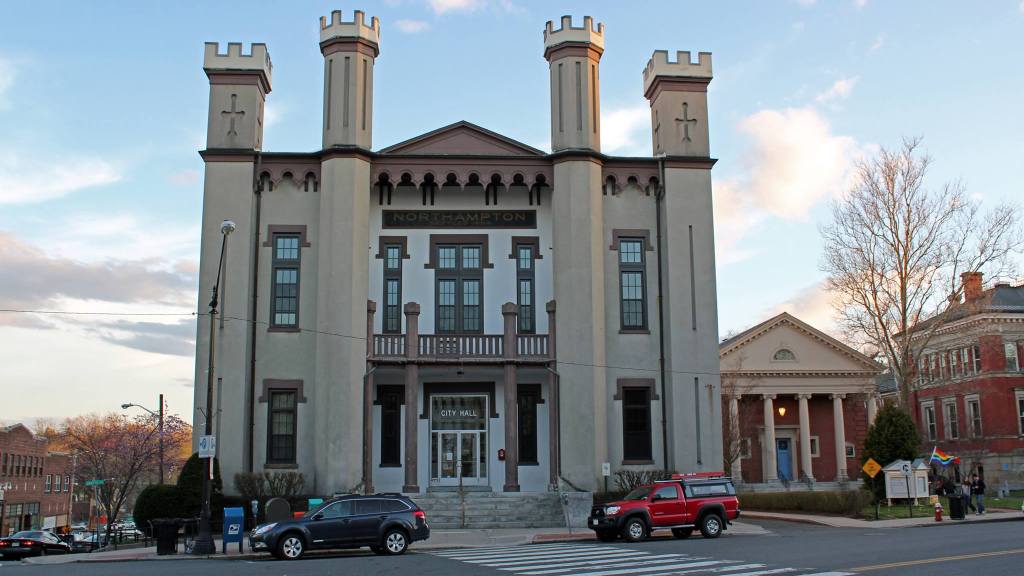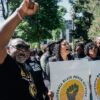
When Mary Olberding stepped in front of the Northampton Reparations Study Commission earlier this year, the information she presented was explosive. Olberding, the elected registrar of deeds in Hampshire County, explained that in her research, she found that to this day, there still exist property deeds in Northampton that include covenants forbidding the sales or rentals of properties to “colored persons” and other ethnic groups.
What’s more, there are organizations still operating locally today that were complicit in those racially restrictive covenants, as they’re known. She said her research revealed there may be as many as 80 or more past and existing racist covenants.
Since that June meeting, however, tensions have run high between reparations commission members, whose work is to propose city initiatives to “support redress and fair treatment for Black people.” At issue is the question of whether to publicly name the present-day organizations that were complicit in those racist property deeds or to reach out to those institutions first. Those disagreements have divided members of the commission, raising larger questions of transparency and scope of the commission’s research and recommendations as they prepare for producing a public report.
In their September and October meetings, the Northampton Reparations Commission spent much time discussing the disclosure of the research on racially restrictive covenants, an apparent centerpiece of the body’s research on historical racism in Northampton. The debate centered around how and when to disclose the past and existing local organizations that are involved in these covenants.
According to Olberding, these covenants often included explicit language forbidding the sales or rentals of properties to “colored persons.” Others were more coded, barring property sales to any “class of persons, whose ownership or occupancy would be injurious to this locality for residential purposes.” At least one other covenant barred sale or occupancy “to any persons who are Polish, Hebrews, or Lithuanians,” Olberding said. And although current federal law renders those agreements illegal and void, she told commissioners the possibility of the Fair Housing Act being overturned concerns her.
“I think these are unprecedented times,” she said. “A few years ago, I might have said, ‘Oh, that’s never gonna be reversed, of course.’ But everything’s being reversed. That’s why I bring up current events, because I think there’s an urgency that I didn’t feel a few years ago.”
If federal housing law was repealed, Massachusetts state laws would likely ensure the racist covenants remain unenforceable. However, Olberding said she believes those covenants still have a direct impact on Northampton today.
“The intent is to intimidate, and had the effect of as if someone had burned down a house to keep people away,” Olberding said. “If that was the intent then, it’s still the intent, even if nobody means to.”
That research has become a point of contention for the commission, which has spent its previous two meetings debating how to disclose information from the covenants in relation to the local organizations that were involved. Commission member Bill Newman, a local civil-rights lawyer and radio host, also researched the covenants, which meant that he was the only member of the commission who had knowledge of details of these deeds and the 16 local organizations he says were involved.
So far, however, Newman has not disclosed that information to his fellow commissioners.
In the commission’s September meeting, Newman explained that he has withheld information about institutional participants of these covenants. Newman said he believes that this information is sensitive and will upset many community members, and suggested that the commission reach out to these involved institutions prior to a full disclosure of the racially restrictive covenants and responsible parties.
Newman argued that the exclusive outreach to these institutions would help to show the goodwill of the commission and to bring these institutions to endorse their work, including potential financial sponsorship for reparations and participation in other forms of relationship-repairing in the community.
“The reality is we want these institutions to back what we are doing,” he said. “It’s not a gotcha moment.”
Commissioner Felicia Lindquist agreed, saying that the commission’s outreach could be an opportunity to “model restorative practices.”
But while some members of the commission were ready to greenlight Newman’s request for institutional outreach, two members of the commission who are themselves Black argued that the request deserved significantly more deliberation with more information.
One of those members, Renika Montgomery-Tamakloe, admitted strong feelings against institutional outreach without knowing more about the involved entities and more time to discuss what this outreach means. And Marsha Morris questioned the restorative benefits proposed by Lindquist.
“For restorative practices … those people approach that together,” Morris said. Those processes don’t work, she explained, in situations where “one side is approaching it from restorative practice and the other side doesn’t know they are in a restorative-practice process.”
Morris also raised concerns about giving involved institutions that may be liable for reparations time to react and prepare.
“I’m surprised that as a lawyer, you would want to give a heads-up to an organization that may be in a situation where they may have to do reparations based on their practice,” Morris said to Newman.
The debate continued in the commission’s October meeting, where Newman declined to provide a synopsis of the racially restrictive deeds to other commission members — something he had initially planned to do. Newman cited the “inherent tension between [the commission’s] need to be transparent with ourselves in the community … and with the institutions [they] are reporting on.”
Newman reiterated his support for institutional outreach before full public disclosure of the covenants, saying he hoped that the entities would be willing to “make a statement regarding participation in reparative efforts” as an addendum to the commission’s report.
Both Montgomery-Tamakloe and Morris reiterated their opposition to Newman’s suggestion from September. Montgomery-Tamakloe recounted the story of her grandfather as an example, who like other Black veterans was denied G.I. Bill educational benefits after serving in World War II. She emphasized that there are grave, generational impacts of historical racial discrimination and that she feels unwilling to give grace to perpetrators of historical racial discrimination.
“As a Black woman, you are asking us to accept less than, and to hold someone’s hand, and say, ‘Yes, you hurt people that look like me, but I don’t want to hurt your feelings because if I hurt your feelings, you won’t help me,’” Montgomery-Tamakloe said.
Morris expressed frustrations around the lack of transparency around these covenants, which she said had empowered Newman to set the parameters of the discussion from the start.
“We’ve been talking about this for quite some time, and Bill, you are still the only person that has seen the information … I especially have an issue with this with you being a white male and determining how this conversation is going to go,” Morris told Newman.
The departure of former commission co-chair Sarah Lynn Patterson seems to have also contributed to the confusion and lack of transparency surrounding the commission’s report. An initial report was due in May and a final report was due in October, but the commission has requested an extension from the mayor. Although commission members have each made suggestions for reparative programs, Morris argued that these suggestions were based on analyses produced by Patterson, who she said never shared with the group despite Morris’ requests.
In the October meeting, tensions also grew around the general direction of the commission, including the scope of the reparative programs and the timeline for their research. Newman proposed to focus the recommendations for reparations on housing based on the discovery of the racially restrictive covenants. He emphasized that these deeds were private deeds between private parties, rather than public ones sanctioned by the city.
Montgomery-Tamakloe suggested that the report must expand beyond housing to also include healthcare, education, safety, and business. To seriously research for reparations, Montgomery-Tamakloe argued, the commission needed more time than allotted for the current timeline of reports. A final report was initially slated for delivery on Oct. 5 before the commission requested an extension.
“We’ve been mentioning for months that we need an extension, that the other cities that we are looking at that have done this work took at least two years,” Montgomery-Tamakloe explained.
Morris added that while she gives credit to Newman’s research on mortgages, the current data they have on housing is incomplete without looking into rentals.
“There’s a huge amount of data about how rentals have been dealt with in this country to exclude African Americans,” Morris said. “And the same thing with the other four areas … And look at what data haven’t we gotten. What data do we think we have that we really don’t understand?”
The commission is scheduled to reconvene on Nov. 5.
The Shoestring is committed to bringing you ad-free content. We rely on readers to support our work! You can support independent news for Western Mass by visiting our Donate page.


